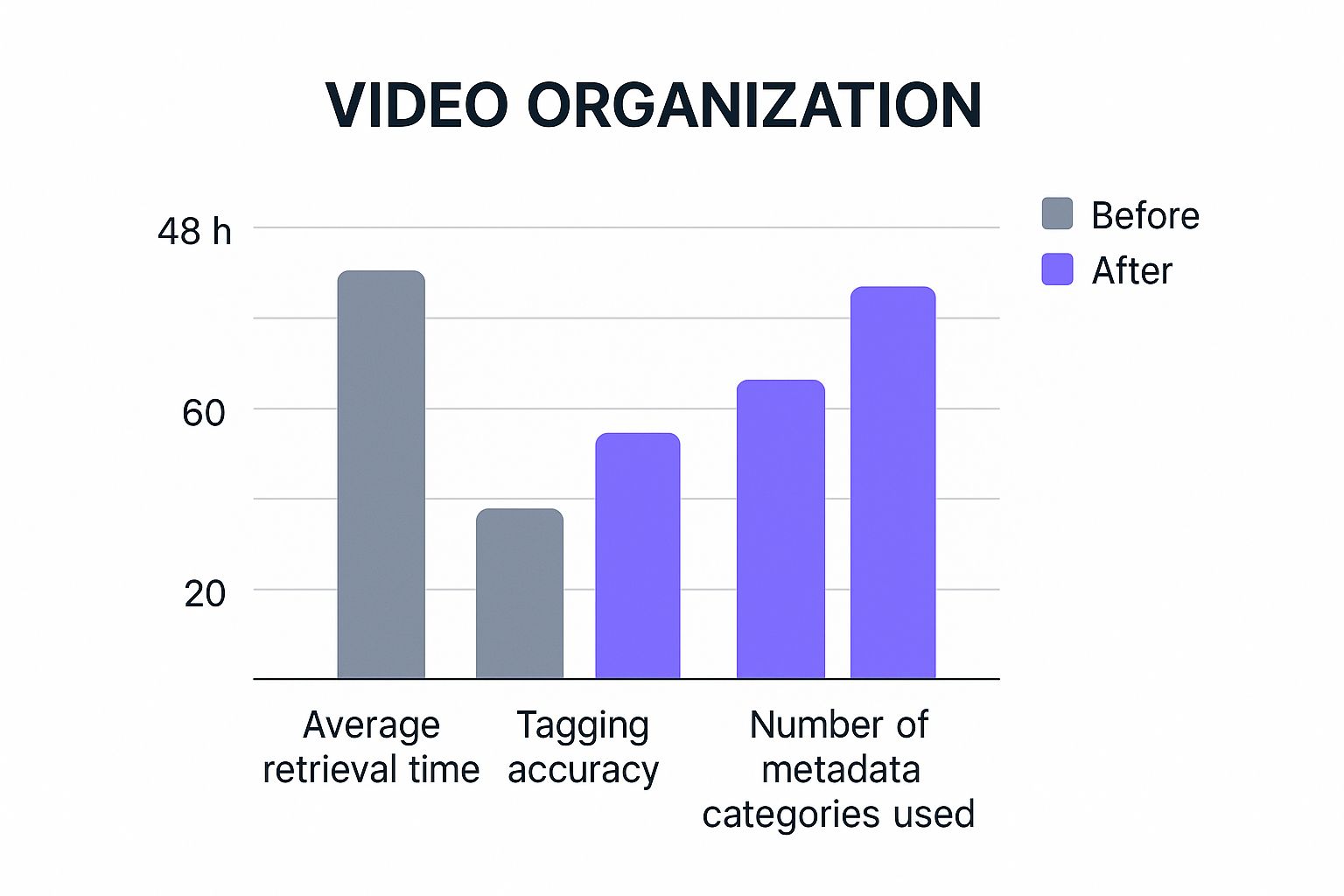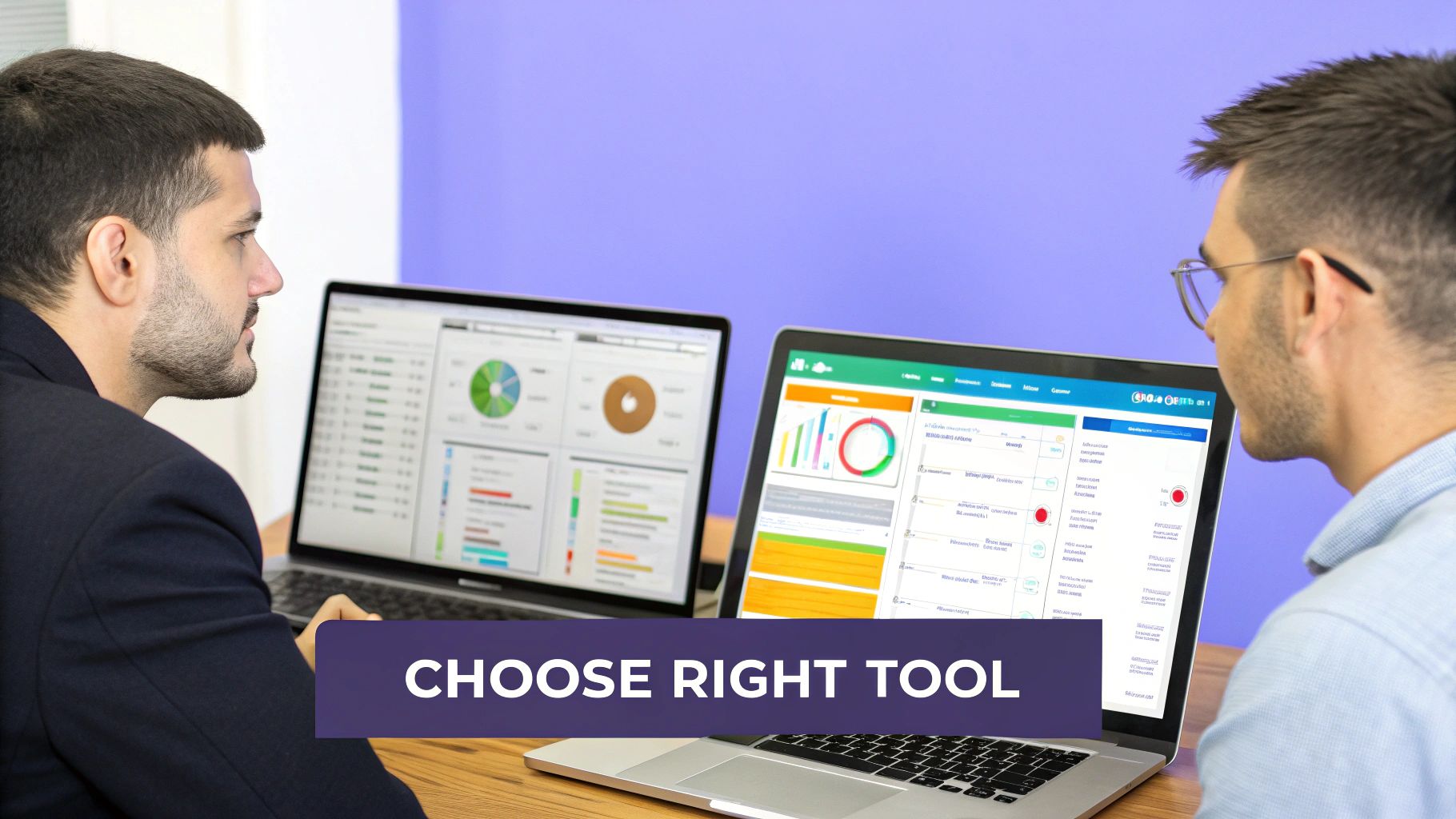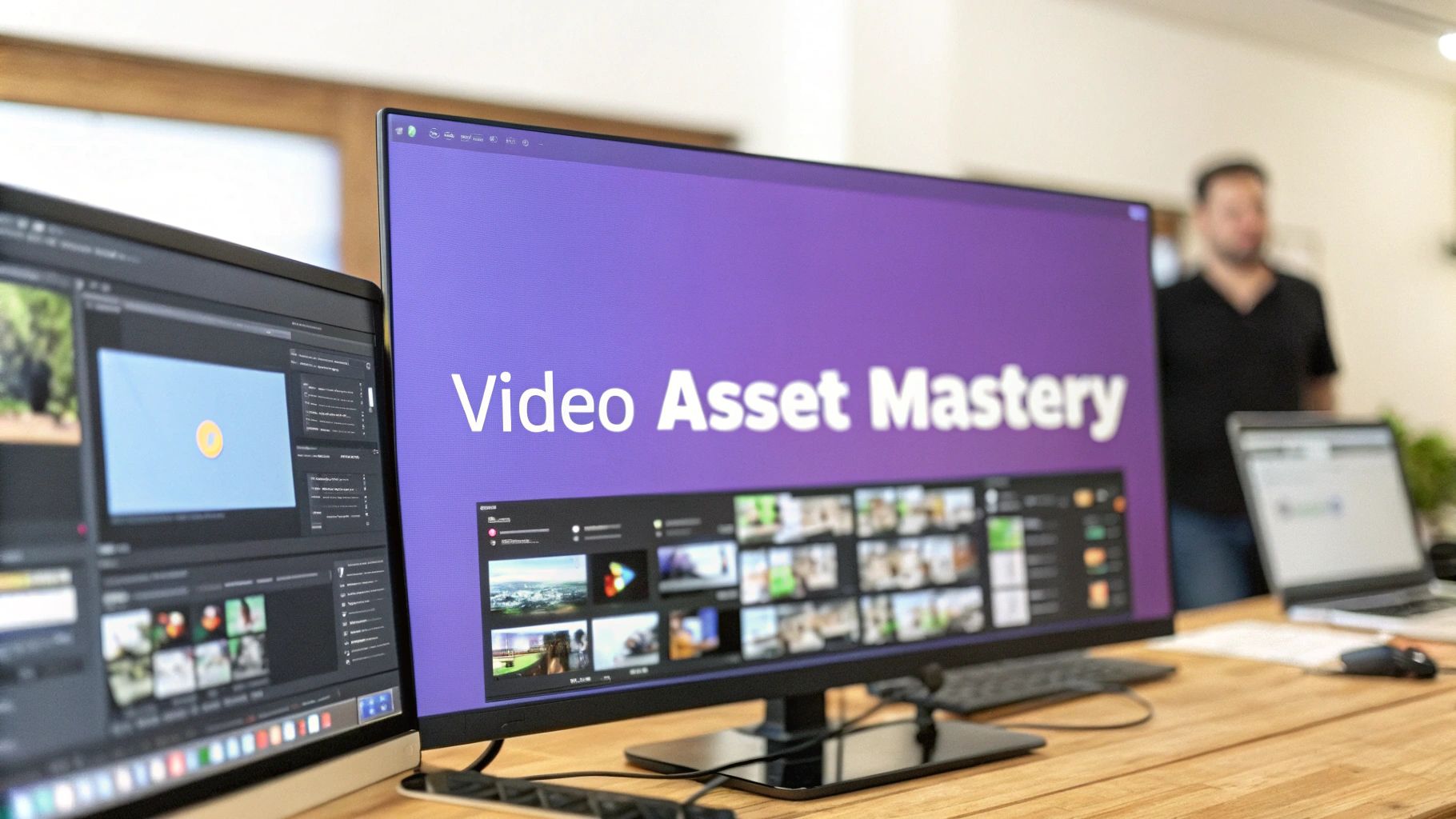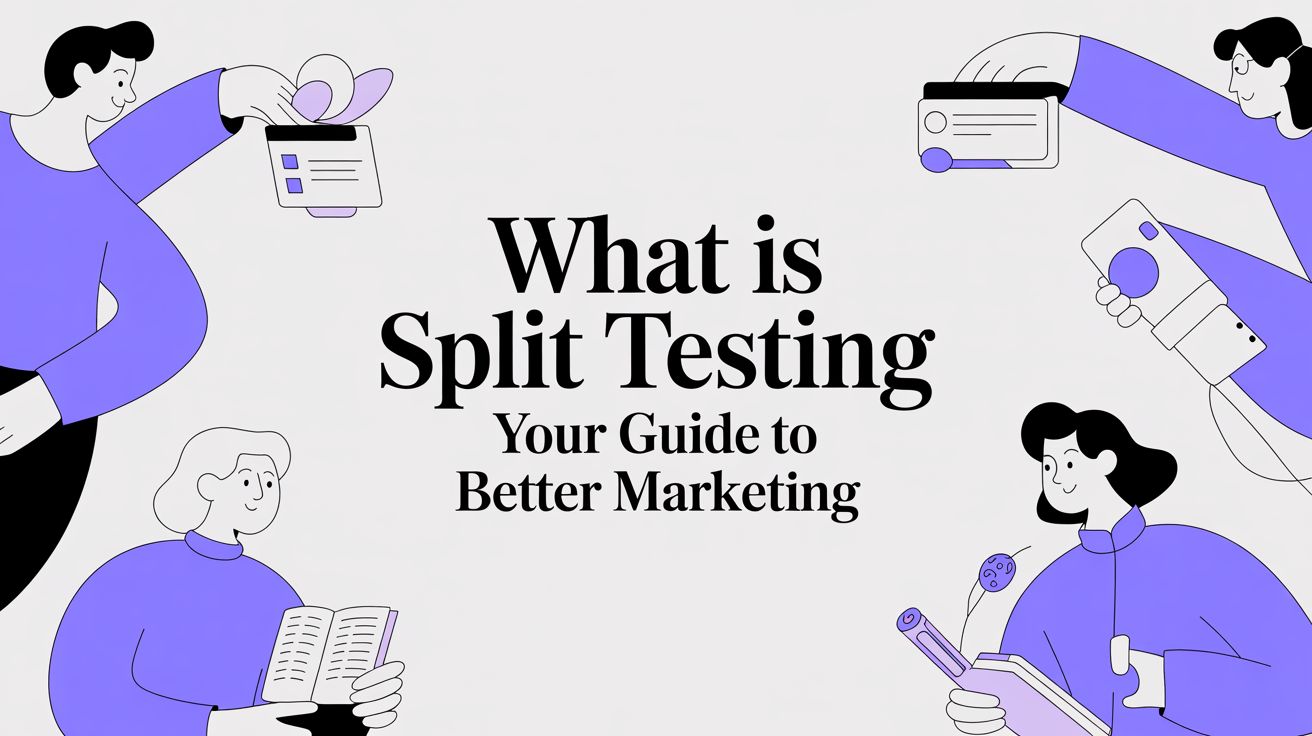Understanding What Video Asset Management Really Means Today
Video asset management (VAM) is more than just storing video files. It's about creating a dynamic ecosystem for all your video content. Think of it as a central hub for your video operations, keeping everything organized and accessible. This structure makes collaboration easier, streamlines workflows, and helps you get the most out of every video.
Beyond Simple Storage: The Core Components of Effective VAM
Effective VAM systems go beyond basic storage. They offer key features that empower content teams, like robust metadata tagging. This lets you search and filter videos with granular detail. Instead of sifting through countless files, you can quickly find specific videos using keywords, descriptions, or even the content within the video itself. Imagine searching for "customer testimonials" and instantly finding all relevant clips.
Version control is another crucial element. It ensures everyone works with the latest video version, preventing confusion, costly errors, and maintaining brand consistency. It’s similar to collaborative document editing, where everyone sees the changes and accesses the current version. Automated workflows are also essential, streamlining approvals and distribution to reduce time-to-market.
Why Traditional Approaches Fail
Traditional video storage methods, often relying on shared drives and disorganized folders, become difficult to manage as video libraries expand. This leads to wasted time searching for files, inconsistencies in branding, and potential legal problems from using outdated or unapproved content. The increasing amount of digital content makes these challenges even greater.
The digital asset management market, including video asset management, is growing rapidly because of this issue. The market was valued at USD 7.73 Billion in 2024 and is projected to reach USD 31.99 Billion by 2033, with a CAGR of 15.26% from 2025 to 2033. You can learn more in the IMARC Group's Digital Asset Management Market Report. This growth highlights the increasing need for effective video asset management solutions.
From Chaos to Control: The Benefits of Modern VAM
Modern VAM systems provide a centralized location for all video assets. This ensures easy access for authorized users while maintaining strong security. They allow seamless collaboration across teams, regardless of location, and offer valuable insights into content performance. This helps organizations maximize their video investment by simplifying content discovery, reuse, and distribution. Effective VAM transforms content operations from a potential frustration into a powerful driver of business growth.
The Real Business Impact of Getting Video Assets Right

A well-implemented video asset management (VAM) system is more than just keeping things organized. It has a direct impact on your bottom line. Imagine the expense of recreating a video simply because you can't find the original file. This happens more often than you might think when video assets aren't managed effectively.
Cost Savings and Efficiency Gains
Leading organizations are saving significant money by using robust VAM systems. These systems eliminate wasted effort, like recreating lost videos. Plus, efficient video asset management helps maximize the reuse of existing assets.
This means companies can repurpose footage for different campaigns or platforms, reducing production costs. Some businesses have reportedly cut content creation costs by up to 40% with smart video asset management.
Time-to-Market Acceleration
Another important benefit is a faster time-to-market. Good video asset management removes the time wasted searching for files and streamlines approvals. This faster workflow allows companies to launch campaigns quicker and take advantage of opportunities.
Think of it like having all the ingredients ready when you're cooking – it speeds up the whole process. It also frees up more time for strategic planning and creative work. You might be interested in: How to master Ecommerce Video Ads.
Enhanced Content Quality and Brand Consistency
Video asset management systems are key for maintaining brand consistency. When everyone can access the right, approved versions of video content, companies can present a unified brand identity across all channels.
This is especially important now, when maintaining a consistent brand message across different platforms is so important for building trust with customers. Streamlined workflows also allow creative teams to focus on quality, resulting in more engaging videos.
Compliance and Security Advantages
Finally, strong VAM systems address crucial compliance and security issues. Proper access controls and permissions ensure that only authorized people can see sensitive video content. This protects your organization from legal risks and safeguards your valuable intellectual property.
Video asset management is becoming essential as companies deal with increasing amounts of video content. Cloud-based solutions, in particular, offer better workflow management, real-time analytics, and improved collaboration. These are all key for efficiently managing video assets. Learn more about the benefits of video asset management here. A robust VAM system can bring significant advantages, from saving money and speeding up time-to-market to improving brand consistency and increasing security.
Must-Have Features That Actually Make a Difference
Not all video asset management (VAM) systems are created equal. Choosing the wrong one can seriously hinder your team's productivity and overall progress. This section breaks down the essential features that separate truly valuable VAM solutions from glorified file storage systems.
Metadata Management and AI-Powered Search
Effective metadata management is the foundation of any successful VAM system. Metadata is the descriptive information attached to each video, such as keywords, descriptions, and even the individuals featured in the footage. This structured data fuels powerful search capabilities, allowing you to quickly locate the exact video clip you need.
Advanced VAM systems utilize AI-powered search, enabling you to find videos based on visual content, objects, and even spoken words within the video itself. This eliminates the tedious and time-consuming process of manual tagging, significantly reducing search time.
Integrations That Amplify Your Workflow
For a truly streamlined workflow, seamless integration with your existing tools is paramount. Your VAM system should integrate with your creative suite, such as the Adobe Creative Suite, allowing for direct import and export of video assets.
Connecting your VAM with your marketing automation platform is also key, enabling efficient distribution and performance tracking of your video content across various campaigns. This integrated ecosystem enhances collaboration and removes friction from your content lifecycle.
Scalable Storage and Global Delivery
As your video library expands, scalable storage becomes increasingly critical. A robust VAM system adapts to your evolving needs, offering flexible storage options that grow alongside your business.
For teams working across different locations, a global content delivery network (CDN) is a must-have. A CDN ensures fast and reliable access to your videos, regardless of where your team members are based. This easy access keeps everyone productive and prevents bottlenecks caused by slow download speeds.
Beyond the Bells and Whistles: Real User Value
Some features may seem impressive during a product demo but lack practical application in everyday use. Prioritize features that directly address your team's specific challenges and contribute to tangible improvements in their workflow. The infographic below visualizes the impact of a well-implemented VAM system. It compares key metrics before and after system implementation, demonstrating the potential for significant improvements in efficiency and productivity.

As illustrated, implementing a robust VAM system can dramatically improve average video retrieval time from 48 hours to just 2 hours. Tagging accuracy can jump from 60% to 90%, and the number of usable metadata categories can increase from 5 to 15.
These improvements translate to substantial time savings, greater efficiency, and better overall utilization of your valuable video assets. By focusing on these core features, you can choose a VAM system that delivers real, measurable value and maximizes your return on investment.
To further illustrate the differences between VAM systems, let's examine a comparison of key features across various levels of solutions.
The following table, "Essential Video Asset Management Features Comparison," outlines core functionalities offered by different types of video asset management systems, ranging from basic to enterprise-level solutions. It also highlights the potential business impact of each feature.
| Feature Category | Basic Systems | Professional Systems | Enterprise Systems | Business Impact |
|---|---|---|---|---|
| Metadata Management | Manual tagging, limited search filters | Automated tagging, advanced search filters, custom metadata fields | AI-powered tagging, robust search with object and speech recognition, extensive custom metadata | Improved search efficiency, reduced time spent on manual tagging, enhanced content discoverability |
| Integrations | Limited or no integrations | Integrations with common creative tools and platforms | Extensive integrations with a wide range of creative, marketing, and business applications | Streamlined workflows, enhanced collaboration, improved data flow across systems |
| Storage & Delivery | Limited storage capacity, basic file sharing | Scalable cloud storage, basic CDN capabilities | Highly scalable cloud or on-premise storage, advanced CDN with global reach, robust security features | Supports growing video libraries, ensures fast and reliable access for distributed teams, enhances content security |
| User Access & Permissions | Basic user roles and permissions | Granular user roles and permissions, customizable workflows | Advanced user roles and permissions, detailed audit trails, comprehensive security controls | Improved content security, enhanced collaboration, streamlined workflows |
This comparison highlights the increasing sophistication and capabilities of VAM systems as you move from basic to enterprise-level solutions. While basic systems offer core functionality for managing smaller video libraries, enterprise systems provide the robust features and scalability needed to support large organizations with complex video workflows.
By carefully considering these features and their potential business impact, you can choose a VAM system that effectively meets your current and future needs.
Technology Trends Reshaping Video Asset Management

The world of video asset management is constantly changing. Keeping up with the latest developments can greatly benefit your organization. These emerging technologies are changing how video content is managed, accessed, and used.
The Power of AI and Machine Learning
Artificial intelligence (AI) and machine learning are transforming video asset management. These technologies automate time-consuming tasks, like tagging videos with keywords and descriptions. This saves countless hours of manual work and makes your video library easier to search.
AI can also analyze video content to identify objects, faces, and even spoken words. This creates richer metadata, enabling precise search results. Finding the right video clip becomes significantly faster and easier.
Cloud-Native Architectures: Collaboration and Scalability
Cloud-native architectures are another important trend. They allow teams to collaborate on video projects from anywhere. This flexibility is vital in today's remote work environments.
Cloud-based systems offer great scalability, adapting to the growing needs of your video library. You won’t need costly hardware upgrades. This adaptability makes cloud-native solutions a cost-effective and future-proof option.
Breakthroughs in Facial and Object Recognition
Advances in facial and object recognition are changing how videos are categorized and searched. Imagine searching your video library for a specific product or person and instantly finding all relevant clips.
This granular searchability opens new possibilities for content discovery and reuse. It also enables automated tagging and categorization, improving your video asset management workflow.
Real-Time Analytics: Insights at Your Fingertips
Real-time analytics offer valuable data on video performance and usage patterns. This data helps organizations understand which videos are most effective and how audiences engage with their content.
These insights can help you improve content strategy and video production, driving better results. Real-time feedback also allows for quick adjustments to maximize the impact of your video content.
Industry experts predict a continued focus on data-driven decision-making. Trends like workflow orchestration automation, facial and object recognition, real-time analytics, and mobile accessibility will fuel growth. The emphasis on personalized content and improved user experience (UX) design also plays a key role. Explore this further here. These trends are shaping the future of video asset management, helping organizations unlock the full potential of their video content.
Implementation Strategies That Actually Work

Implementing a video asset management (VAM) system effectively is critical for success. Meticulous planning and careful execution are essential for thriving projects. A strategic approach is required, addressing several key aspects.
Conducting A Thorough Content Audit
Before selecting a VAM system, a comprehensive content audit is vital. This involves cataloging your existing video assets, identifying formats, and understanding current storage methods.
This audit helps you grasp the true scope of your video library. It allows you to choose a system that truly fits your needs, much like taking inventory before a move. You need to know what you have before choosing the right boxes and truck.
Establishing Clear Governance Frameworks
Governance frameworks are crucial for long-term success with your VAM system. These frameworks define roles, responsibilities, and workflows.
Establishing clear guidelines for uploading, tagging, and approving videos promotes consistency and prevents confusion. Think of it as setting the rules of the road for everyone using the system.
Developing Scalable Metadata Standards
Developing consistent metadata standards is equally essential. Metadata is the descriptive information attached to each video, making your content searchable and retrievable.
A standardized tagging system, utilizing keywords and categories, helps everyone find the videos they need. This keeps your system efficient, even as your library expands. You might find this helpful: How to master Video Ad Automation.
Avoiding Common Implementation Mistakes
Many VAM implementations stumble due to common pitfalls. Inadequate user training can leave team members unsure of how to utilize the system.
Poor change management can lead to resistance and low adoption. Addressing these proactively is key to successful implementation. Another frequent mistake is neglecting stakeholder engagement.
Early stakeholder involvement builds buy-in. It helps ensure the system truly meets everyone's needs, fostering a smoother transition and promoting long-term success.
Ensuring User Adoption and Driving Success
Proven strategies for user adoption include comprehensive training programs and ongoing support. Regular communication keeps users informed of updates and best practices.
Recognizing and rewarding early adopters creates positive momentum. Finally, defining clear success metrics is essential.
Tracking key performance indicators (KPIs), such as video retrieval time and content reuse rates, demonstrates the system's value. This data-driven approach justifies the investment and ensures ongoing support for your VAM system. By following these strategies, organizations can realize the true potential of their VAM implementation, setting the stage for long-term success.
Proving ROI and Measuring What Actually Matters
Demonstrating the value of your video asset management investment means focusing on the right metrics. It's not just about organization; it's about showing how a robust system positively impacts your bottom line. This involves selecting key performance indicators (KPIs) that truly resonate with executives and stakeholders.
Establishing Meaningful Baselines and Tracking Progress
Before implementing any video asset management system, establish clear baselines for your current processes. Consider how long it takes, on average, to locate a specific video file. What are your present content creation costs? These initial measurements provide a benchmark to track improvement after implementing a new system.
This allows you to demonstrate tangible progress and justify the investment. For instance, if a new video asset management system reduces video retrieval time from hours to minutes, that time saving translates into cost savings and increased productivity. This data-driven approach makes a compelling case for the system's value. You might be interested in: How to master AI Marketing Video.
Calculating Tangible and Intangible ROI
Calculating ROI involves measuring both tangible and intangible benefits. Tangible ROI includes direct cost savings like reduced content creation costs due to easier asset reuse. It also includes increased revenue from faster time-to-market.
Intangible ROI, while harder to quantify, is also important. This includes improvements in brand consistency, enhanced collaboration, and improved user satisfaction. While not directly tied to revenue, these benefits contribute to overall organizational efficiency and long-term success.
Measuring User Satisfaction and System Adoption
User satisfaction is crucial for successful video asset management implementation. Track system adoption rates and gather user feedback to identify areas for improvement. High adoption rates and positive feedback demonstrate the system's value and positive impact on workflows. Measuring improvements in content discoverability offers insights into the system's effectiveness.
Building an Ongoing Business Case
Successful organizations build ongoing business cases for continued investment in video asset management. They demonstrate value by showcasing KPI improvements, user testimonials, and practical examples of how the system streamlines operations and supports business goals.
This proactive approach ensures continued support and secures resources for future development and optimization. Highlighting both immediate and long-term benefits creates a compelling argument for sustained investment.
Frameworks for Continuous Improvement
Implementing a video asset management system isn't a one-time project. It requires ongoing monitoring and optimization. Establish frameworks for continuous improvement and performance monitoring. Regularly review system usage data, gather user feedback, and identify areas for adjustments to enhance efficiency and maximize value.
This commitment to continuous improvement ensures your system remains a valuable asset, adapting to evolving needs and supporting your long-term content strategy. Prioritizing user feedback and using a data-driven approach allows you to continually refine your system and maximize its business impact.
To illustrate a practical approach to measuring ROI, consider the following table:
The table below outlines key performance indicators and measurement methods for tracking video asset management success. This framework helps visualize how different metrics contribute to overall ROI.
| Metric Category | KPI | Measurement Method | Typical Improvement Range | Business Impact |
|---|---|---|---|---|
| Content Creation Efficiency | Time to produce a video | Track project timelines from ideation to completion | 10-30% reduction | Lower production costs, faster time-to-market |
| Asset Reusability | Number of times an asset is reused | Analyze asset usage data within the system | 20-50% increase | Reduced content creation costs, increased content output |
| Content Discoverability | Time spent searching for assets | User surveys, system usage logs | 50-80% reduction | Increased team productivity, improved workflow efficiency |
| System Adoption Rate | Number of active users | Track logins and system usage | 70-90% adoption | Increased team collaboration, maximized system ROI |
| User Satisfaction | User satisfaction score | User surveys, feedback forms | 10-20% improvement | Increased user engagement, positive impact on workflows |
This framework helps establish quantifiable targets for improvement and provides a clear method for tracking progress and demonstrating the value of your video asset management system. By focusing on these metrics, you can build a compelling case for continued investment and ensure that your system delivers maximum ROI.
Key Takeaways
This section offers a practical guide to successful video asset management (VAM), based on industry best practices and real-world examples. Here’s a summary of key takeaways to help you on your journey.
Actionable Checklists For Success
We've compiled actionable checklists to guide you through each phase, from system evaluation and implementation planning to measuring success. These checklists provide concrete steps you can start using right away.
Evaluating Systems: Figure out your essential features based on your organization's specific needs. Think about things like metadata management, search capabilities, and integrations with existing tools.
Planning Implementation: Create clear project timelines, assign roles and responsibilities, and develop a communication strategy to keep everyone informed.
Measuring Success: Choose relevant key performance indicators (KPIs) to track your VAM system's effectiveness. These could include metrics like reduced content creation costs, faster time-to-market, or improved content discoverability.
Benchmarks For Tracking Progress and Celebrating Wins
Clear benchmarks are crucial for measuring progress and recognizing achievements. Set specific, measurable, achievable, relevant, and time-bound (SMART) goals. For instance, you might aim to cut video retrieval time by 50% within the first three months.
Tracking these metrics helps demonstrate your VAM system's value and celebrate milestones. This data-driven approach keeps the project moving forward and reinforces the system's importance.
Identifying Warning Signs and Success Indicators
Recognizing the warning signs of an ineffective approach is key for quick intervention. If you're having trouble finding video files, struggling with inconsistent branding, or facing content approval bottlenecks, these are signs that your current system needs work.
On the other hand, positive indicators like lower content creation costs, better collaboration, and faster time-to-market indicate that your VAM strategy is working. Knowing these signs helps you proactively address potential issues and build on what's working well.
Realistic Timelines and Budget Planning Guidelines
Implementation timelines depend on the size and complexity of your organization. Smaller organizations might finish implementation in a few months, while larger companies might need more time. Realistic timelines account for possible delays and ensure a smooth transition.
Budget planning is essential, too. Include the cost of software licenses, implementation services, training, and ongoing maintenance. A thorough budget makes sure you have the resources for successful implementation and long-term operation.
Change Management Strategies For Lasting Value
Implementing a new VAM system often means changing workflows and processes. Effective change management is crucial for user adoption and maximizing the system's impact.
Provide comprehensive training so users have the skills to use the system efficiently. Clear communication keeps stakeholders informed and addresses any concerns. These strategies create a smooth transition and build the foundation for long-term success.
Learn more and start your free trial with Sprello today. Sprello offers an AI-driven solution to help organizations efficiently create high-performing video ads. Streamline your video creation and maximize your ROI.



